Discover the best locations for raising children
A healthy environment plays a vital role in supporting a child’s growth and development by shaping their health and well-being.
Whether it’s access to top-tier education or the quality of healthcare, such as prioritizing the responsible use of prescription drugs and ensuring all medical treatments are safe and effective, some exemplary locations stand out both in the US and across the globe for their approach to offering the best possible settings for children to thrive.
To help you discover the best places to raise children, we explore factors that contribute to a healthy childhood, from obesity rates to mental health. We not only highlight the best and worst states in which to raise a child, but we also look through a global lens to spotlight the healthiest countries that positively impact children's growth.
Healthiest states for children
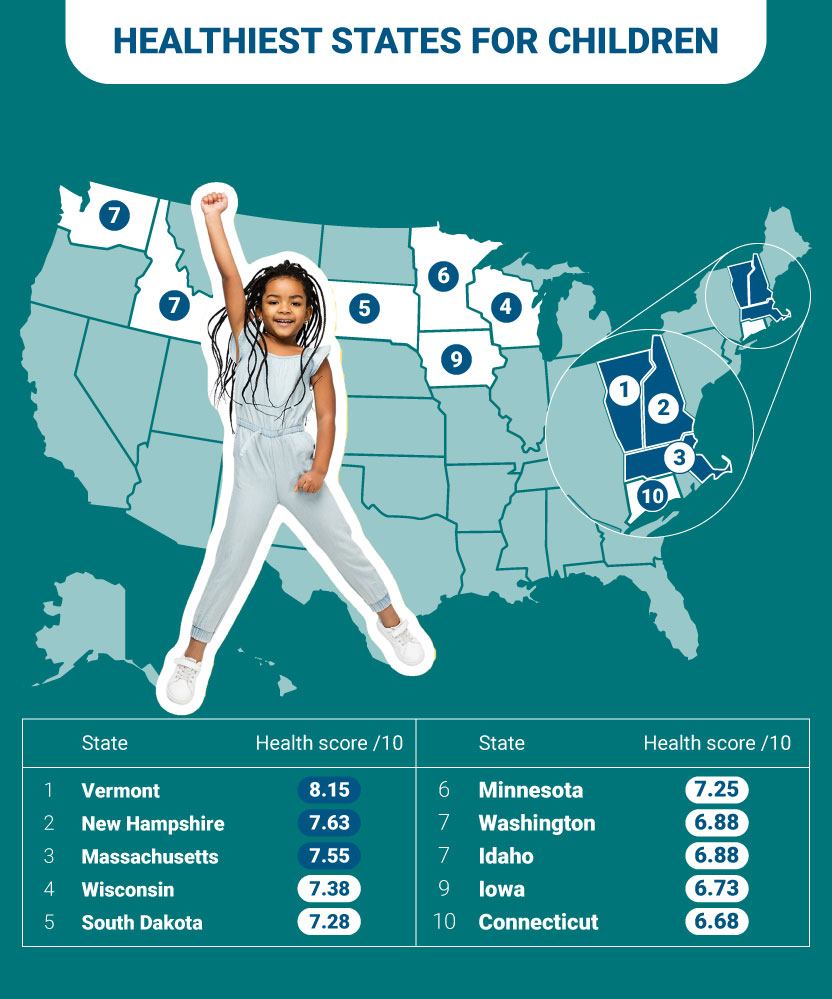

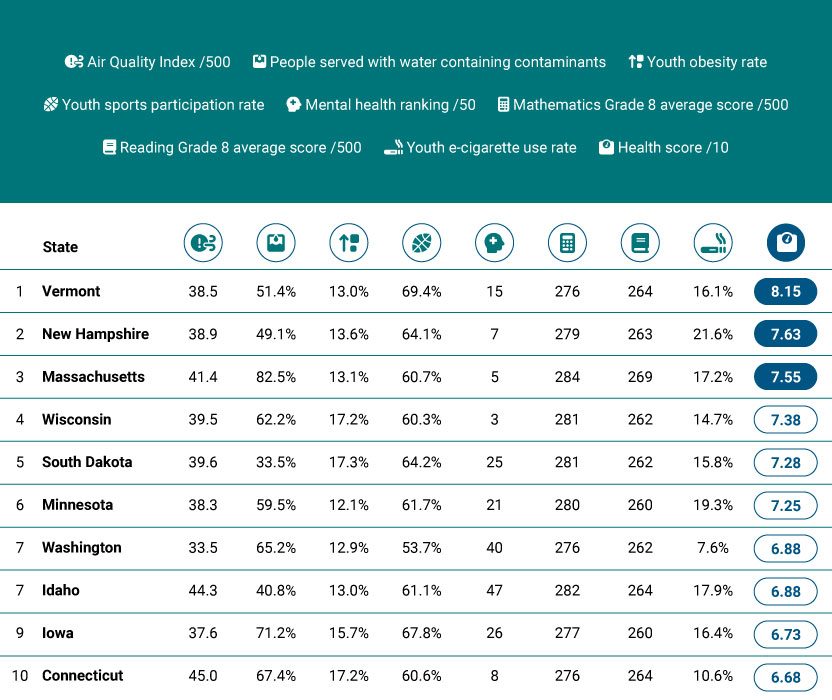

- Vermont - 8.15/10
Vermont tops the list as the healthiest state for children, scoring 8.15 out of 10. The northeastern state not only has the highest rate of youth sports participation (69.4%) than any other state, but it is also in the top five states with the lowest rates of childhood obesity (13%).
This is unsurprising as Vermont adopts a proactive approach toward children's health, offering programs such as Medicaid and the Children's Health Insurance Program (CHIP). These provide no-cost or low-cost health coverage for eligible children in Vermont, aiding in routine check-ups, dental care, and immunizations that help keep children healthy.(1) - New Hampshire - 7.63/10
New Hampshire ranks second, with a score of 7.63 out of 10. The state is in the top 10 with the lowest prevalence of mental illnesses, such as depressive episodes, substance use, and emotional problems. It also has higher access rates for youth care and individualized education programs for youths with emotional disturbances. This is no surprise, as it offers medical assistance, including health coverage, to children under 19.(2)
Regarding proficiency in education, New Hampshire is among the top 10 states with higher performance scores in eighth grade math and reading than the national public average, making it one of the country’s best states for early learning. - Massachusetts - 7.55/10
Massachusetts has some of the best school systems in the United States. The state had the highest average score in eighth grade math and the second highest average for eighth grade reading, approximately 4% higher than the national average in both subjects.
It also ranks in the top five as one of the states with the lowest prevalence of mental illness among youth, meaning that youths who experience a major depressive episode are more likely to receive mental health treatment than in other states.
Massachusetts is among the top 10 states with the lowest childhood obesity rates (13.1%). Therefore, it’s no wonder it is one of the top three healthiest countries, scoring 7.55 out of 10.
Unhealthiest states for children
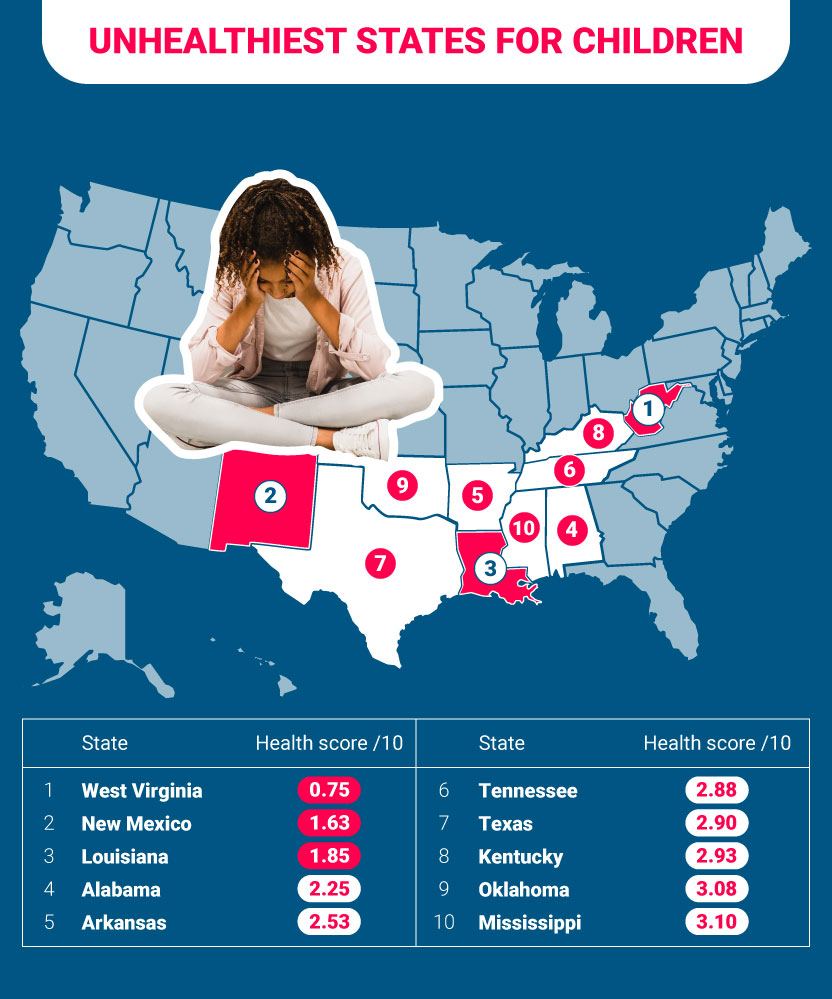

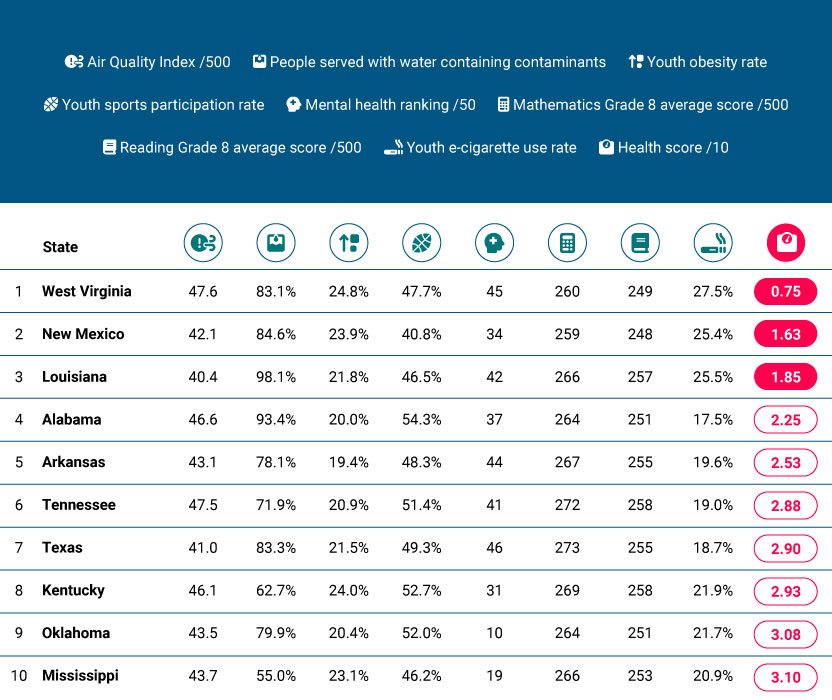

- West Virginia - 0.75/10
West Virginia has the lowest score of 0.75 out of 10, making it the unhealthiest state to raise a child. The eastern state has the highest childhood obesity rate of any state, with almost a quarter of children (24.8%) being above a healthy weight. This could impact it being among
the top five states with the lowest youth sports participation rates, with just under half (47.7%) of children participating in physical activity.
Mental illness is also quite prevalent among West Virginia's youth, meaning it has lower youth care access rates. In addition, not only is the state in the top five for poor air quality (47.6), but it also has the second-highest rate of e-cigarette use among youths (27.5%), just behind Wyoming.
The state also needs to improve education, with low proficiency rates in eighth grade math and reading, approximately just under 5% below the national average in both subjects. - New Mexico - 1.63/10
In second place is New Mexico, with a score of 1.63 out of 10. The landlocked state has the lowest proficiency rate in eighth grade math and reading among all other states and is over 4% below the national average in both subjects. It also has one of the highest rates of youths using e-cigarettes (25.4%), as although youth smoking is less prevalent these days, e-cigarette use has become more of a significant concern.
New Mexico has the lowest rate of youth participation in sports, with less than half (40.8%) of young people taking part in physical activity. This also correlates with the state’s obesity rate. Around a quarter of children (23.9%) are considered at an unhealthy weight. As a result, New Mexico has the third highest rate of childhood obesity across all states.
The state is also in the top 10 for people served with water contaminants above health guidelines (84.6%), which can expose children to gastrointestinal and stomach disorders. In some cases, it can lead to exposure to toxic substances like lead, which, in the long term, may result in permanent neurological damage, especially in young children. - Louisiana - 1.85/10
Louisiana is the third unhealthiest state for raising children, scoring 1.85 out of 10. The southwestern state ranks first with the highest percentage of people served with contaminants found above health guidelines (98.1%).
It is also in the top five states, both with the highest rate of childhood obesity (21.8%) as well as the lowest youth participation in sports (46.5%). Physical inactivity and unhealthy eating habits in children can cause the development of chronic diseases like heart disease and type
2 diabetes. Childhood obesity affects not only physical health but also emotional well-being, as it can result in children having low self-esteem and depression relating to a negative body image.
In addition, Louisiana has one of the highest levels of mental illness among youth while also having one of the lowest averages for eighth grade math - just under 3% below the national average.
Healthiest countries for children
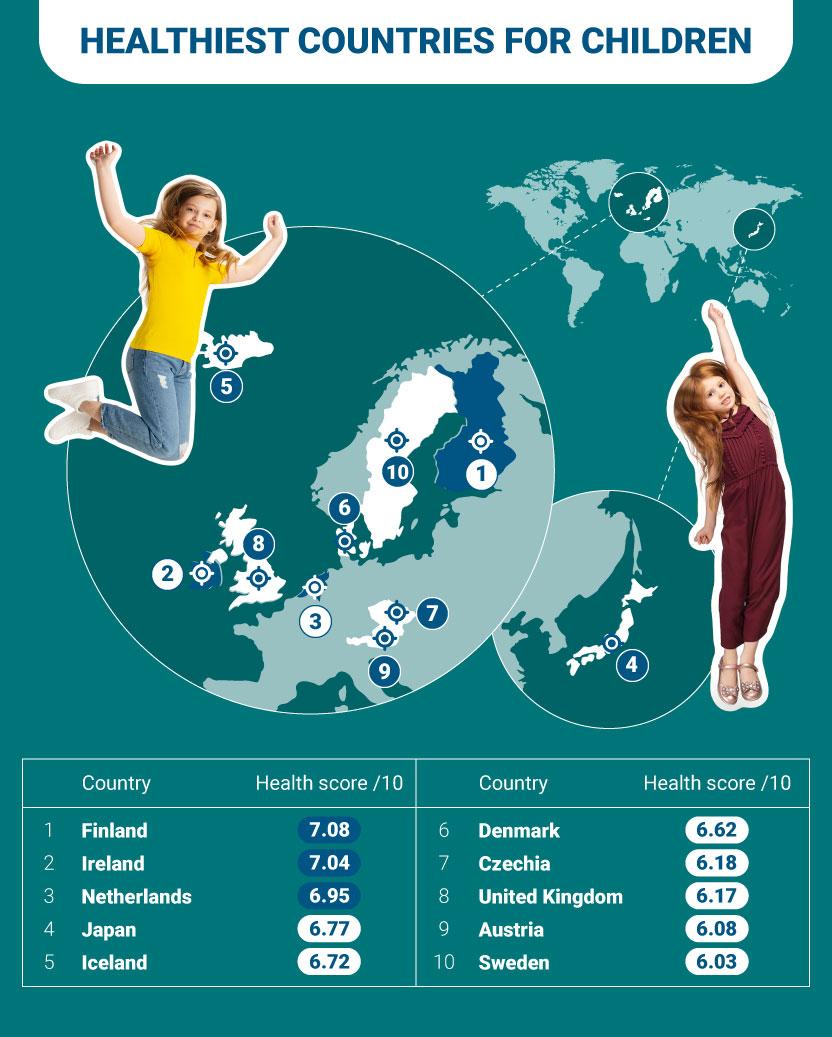

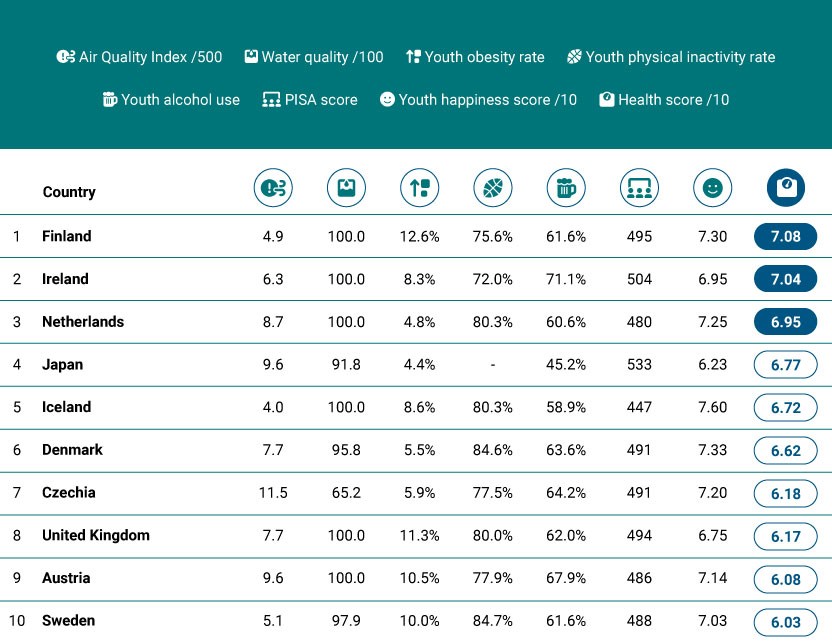

- Finland - 7.08/10
Finland grabs first place as the healthiest country to raise a child, scoring 7.08 out of 10. It ranks among the highest destinations for clean, safe drinking water with a quality of 100, the highest score.
Finland also has one of the cleanest air quality in the world (4.9), ranked in the top five. Therefore, it's no wonder the country is one of the top places where youths have the highest happiness score, scoring 7.3 out of 10, alongside Luxembourg.
Regarding education, Finland ranks in the top 10 with one of the highest PISA scores3. This score combines students' average math, reading, and science proficiency worldwide. The country’s average scores are almost 12.5% higher than the global average. - Ireland - 7.04/10
Ireland is second, with a score of 7.04 out of 10. It ranks as one of the best countries for safe drinking water, with a water quality score of 100. Alongside Norway, it is also in the top 10 for air quality, with a score of 6.3.
Ireland has the second-lowest rate of insufficient physical activity (72%) among adolescents compared to other countries, meaning a more active youth population. The country is also proficient in education, as it is in the top 10 with one of the highest PISA scores – 14.5% higher than the global average. - Netherlands - 6.95/10
In third place is the Netherlands, with a score of 6.95 out of 10. Much like Finland and Ireland, the Netherlands also scores very highly for its water quality (100), achieving the highest level of clean, safe drinking water.
The country has also adopted a healthy and environmentally conscious lifestyle, from eating more plant-based products to cycling as a major form of transport. Unsurprisingly, it is in the top five countries with the lowest childhood obesity rates (4.8%) and the top 10 for being the happiest destination for the youth population, with a happiness score of 7.25 out of 10.
Unhealthiest countries for children
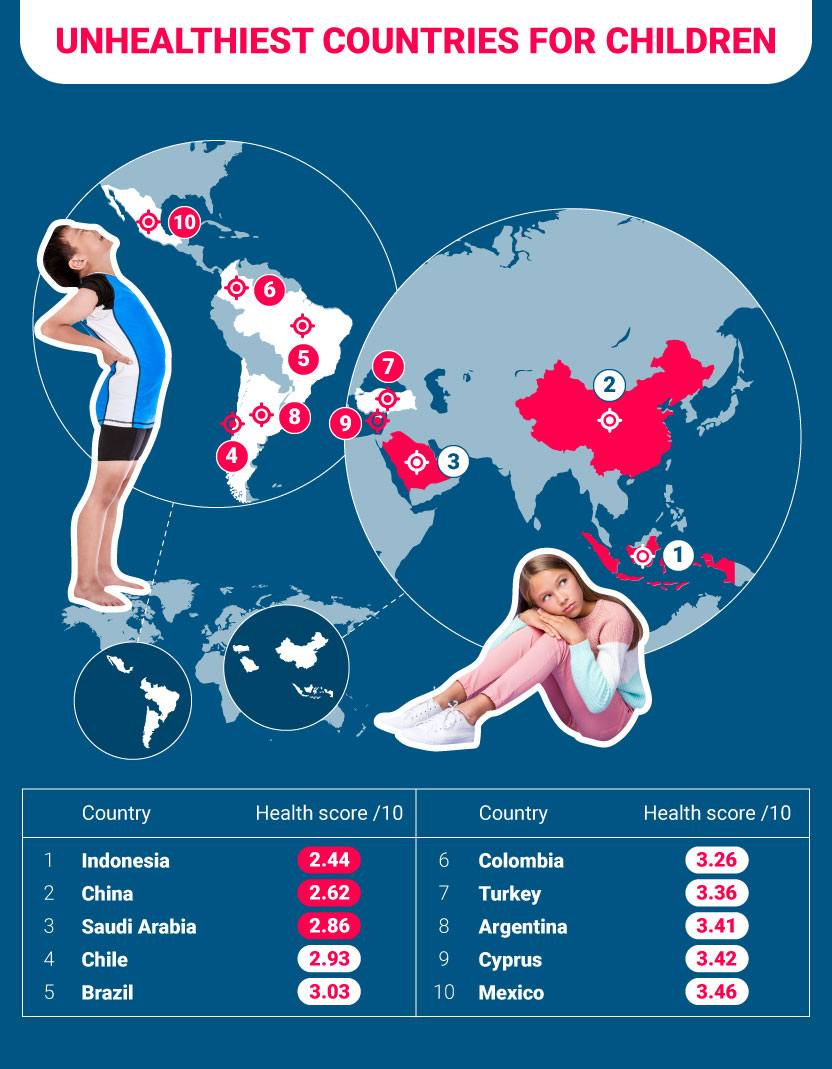

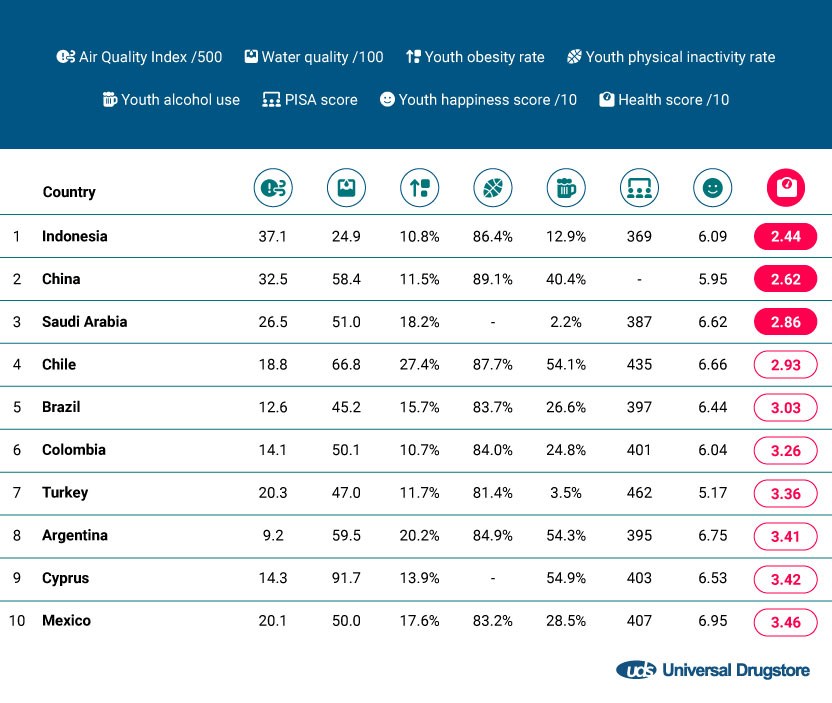

- Indonesia - 2.44/10
Indonesia is the unhealthiest country to raise a child, scoring 2.44 out of 10. It also has the lowest PISA scores, 16% below the global average. In addition, it is among the top 10 countries where adolescents have insufficient physical activity (86.4%).
Unfortunately, Indonesia also has the second-lowest air quality (37.1) and the third-lowest water quality (24.9 out of 100), potentially resulting in one of the lowest happiness scores among youth, scoring 6.09 out of 10. However, the country does have a relatively low alcohol use (12.9%) among adolescents compared to other countries, ranking third. This low rate is likely due to religious restrictions surrounding alcohol consumption. - China - 2.62/10
With a score of 2.62 out of 10, China is second among the unhealthiest countries for children. China has a high prevalence of physical inactivity, often leading to poor health. The country has the second-highest level of insufficient physical activity among adolescents (89.1%).
China also has the third-worst air quality (32.5) due to its immense urban growth and substantial increase in traffic congestion and energy use, which cause large amounts of air pollution. Exposure to air pollution can significantly reduce lung function, resulting in childhood asthma and allergies and, in more severe cases, cardiovascular diseases or respiratory issues such as bronchitis symptoms.
China's happiness index score of 5.95 out of 10 places it among the top five countries with the lowest happiness score among youth. - Saudi Arabia - 2.86/10
Saudi Arabia completes the top three, scoring 2.86 out of 10. The Middle Eastern country has the second-lowest average PISA score, 12% lower than the global average. It ranks fourth among the nations for both the poorest air quality (26.5) and the highest obesity rate (18.2%).
Additionally, it is in the top 10 for having one of the poorest water quality, 51 out of 100.
On the other hand, Saudi Arabia has the lowest level of alcohol use among adolescents (2.2%) compared to all other countries, indicating that alcohol is not a major issue among the youth due to the country’s strict laws against alcohol consumption.
Dr Jamie Winn PharmD at Universal Drugstore, comments on how a child’s environment can have a significant impact on their health: “Children require a healthy and safe environment to grow, learn, explore, and develop. A poor environment can significantly impair a child’s health and intellectual, emotional, and social growth, as they are particularly vulnerable to environmental risks.
Consider relocating to areas with healthier surroundings to ensure your child's best possible start in life. Location can significantly enhance their prospects for growth and development.
Healthier states and countries tend to provide better education, improved healthcare, and access to cleaner air and recreational facilities. These aid in advancing your child’s physical and cognitive development and can positively impact their self-esteem and self-image.
For example, although New York is a popular destination for many, it does not offer the best opportunities for raising a child. It has a considerably high number of people being served with water-containing contaminants (90.3%) and a relatively high level of youth obesity (15.9%).
Vermont, its neighboring state, has much better prospects, with better education, higher youth sports participation rates (69.4%), less childhood obesity (13%), and over 50% of people less likely to be served water-containing contaminants than New York.
Vermont is also a neighbor to other healthy states, including New Hampshire and Massachusetts, which comprise the top three healthiest states for children.
In summary, factors affect a child’s early years and can cause developmental delays later in life. That’s why children need to be given the opportunity to thrive in child-friendly environments. Access to healthcare services, healthy food, and open green spaces can improve their overall development and well-being.”
Methodology
US data:
We used USA.com to gather data on air quality in every state in the US, ranking the data from worst to best. The highest figures indicate poor air quality, while the lowest indicate good air quality. This data was collected on 05/28/2024.
Water quality data was collected using EWG’s Tap Water Database, which considers the 2021 figures for the percentage of the average number of people served with contaminants found above health guidelines for each state. This was calculated by summing up the number of people served with contaminants above the health guidelines and then normalized as a percentage of each state’s population.
Obesity rates were scoured by the State of Childhood Obesity from 2021-22. This data ranks the percentage of obesity for each US state from the lowest to the highest.
The youth sports participation rates in the US were taken from Voronoi, highlighting the percentage of sports participation among children ages 6-17 in 2022.
Data on mental health among youth was taken from Mental Health America (2023) and ranked each state based on several measures. The higher-ranking states have a lower prevalence of mental illness and higher rates of access to care for youth. In comparison, states with lower rankings indicate a higher prevalence of mental illness and lower rates of access to care.
Using 2022 data from The Nation’s Report Card, we sourced each state's average proficiency score for grade eight math and reading. The average score is based on a scale from 0 to 500 and highlights the national average.
The youth smoking and e-cigarette rates were taken from TobaccoFreeKids.org, which looks at the percentage rate of young smokers, among many other factors. This data was taken from the 2023 National Youth Tobacco Survey (NYTS).
To reveal the healthiest places overall, we created a ‘health score’ out of 10 by giving each state a normalized score out of 10 for each factor, including the air quality, water quality, obesity rate, youth sports participation rate, mental health ranking, proficiency rate in math and reading and youth e-cigarette rates. We then calculated the overall score out of 10 across all factors for each state.
Global data:
We created a list of 50 countries compiled from the OECD, EU, and G20 countries. We did not include Russia and Israel due to their controversial nature.
We used IQAir to gather the 2023 data on air quality in every country, ranking the data from worst to best. The air quality index ranges from 0 to 500. Higher figures indicate poor air quality, while lower figures indicate good air quality.
Water quality data was collected using the Environmental Performance Index (2022), which measures unsafe drinking water using age-standardized disability-adjusted life-years lost per 100,000 persons (DALY rate) due to exposure to unsafe drinking water. A score of 100 indicates a country has among the lowest DALY rates in the world, while a score of 0 indicates a country is among the highest.
Obesity rates were scoured through the Global Obesity Observatory (2022), looking specifically at the overall average obesity percentage for male and female children. This data ranks the percentage of obesity for each country from the lowest to the highest.
The youth inactivity rates were taken from Unicef (2021), which looked at the ‘insufficient physical activity rates’ among school-going adolescents and calculated the overall average for males and females combined. This source was also used to note down the average ‘alcohol use’ among adolescents in each country, also taking the overall average for males and females combined.
Data on mental health among youth was taken from the World Happiness Report. We used Figure 2.2, which ranks the happiness of the young (under 30) out of 10 in every country from 2021 to 2023.
Using 2022 data from Data Pandas, we sourced each country’s overall PISA score, considering math, reading, and science proficiency. We also looked at the global average.
To reveal the healthiest places overall, we created a ‘health score’ out of 10 by giving each country a normalized score out of 10 for each factor, including the air quality, water quality, average obesity rate, insufficient physical activity, average alcohol use, PISA scores, and the average happiness score. We then calculated the overall score out of 10 across all factors for each country.
References:
- https://www.insurekidsnow.gov/coverage/vt/index.html#:~:text=Medicaid%20and%20the%20Children's%20Health,care%20to%20keep%20them%20healthy
- https://www.dhhs.nh.gov/programs-services/medicaid/nh-medicaid-medical-assistance-eligibility/nh-medicaid-medical
- PISA is a globally recognized benchmark in the Program for International Student Assessment (PISA), a triennial survey run by the Organization for Economic Cooperation and Development (OECD) that assesses 15-year-olds' abilities in reading, mathematics, and science.








